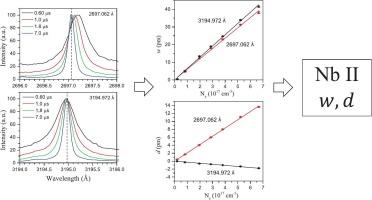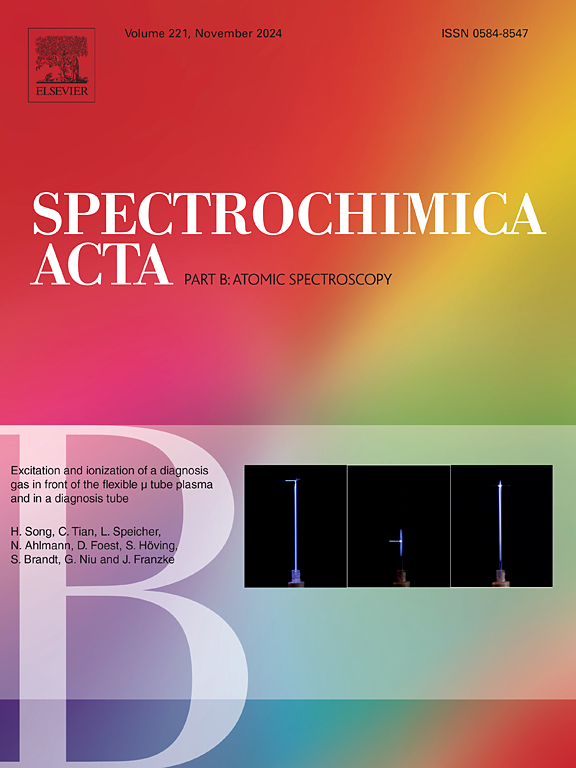铌II谱线的实验Stark宽度和位移
IF 3.8
2区 化学
Q1 SPECTROSCOPY
引用次数: 0
摘要
用激光诱导击穿光谱(LIBS)测量了铌II谱线的斯塔克宽度和位移。实验谱线是从激光诱导等离子体的发射光谱中获得的,这些等离子体是由硼酸盐与小铌浓度融合制备的样品产生的,选择最小的自吸收。利用不同的探测延迟时间,电子密度在0.81 × 1017 cm−3到6.7 × 1017 cm−3之间,温度在10,100-16,700 K之间。确定的26个斯塔克宽度和22个斯塔克位移包括10个多胞胎和3个构型之间转换的光谱线。据我们所知,在以前的文献中只有两个Nb II Stark宽度的实验数据。本文章由计算机程序翻译,如有差异,请以英文原文为准。

Experimental Stark widths and shifts of Nb II spectral lines
Stark widths and shifts of Nb II spectral lines have been measured by laser-induced breakdown spectroscopy (LIBS). The experimental line profiles are obtained from spectra of the emission of laser-induced plasmas generated with samples prepared by borate fusion with small niobium concentrations, selected to minimize self-absorption. Using different time delays in the detection of the emission, electron densities ranging from 0.81 × 1017 cm−3 to 6.7 × 1017 cm−3 and temperatures in the interval 10,100–16,700 K are employed in each measurement. The 26 Stark widths and 22 Stark shifts determined include spectral lines from transitions between 10 multiplets and 3 configurations. To our knowledge, only two experimental data for Nb II Stark widths were available previously in the literature.
求助全文
通过发布文献求助,成功后即可免费获取论文全文。
去求助
来源期刊
CiteScore
6.10
自引率
12.10%
发文量
173
审稿时长
81 days
期刊介绍:
Spectrochimica Acta Part B: Atomic Spectroscopy, is intended for the rapid publication of both original work and reviews in the following fields:
Atomic Emission (AES), Atomic Absorption (AAS) and Atomic Fluorescence (AFS) spectroscopy;
Mass Spectrometry (MS) for inorganic analysis covering Spark Source (SS-MS), Inductively Coupled Plasma (ICP-MS), Glow Discharge (GD-MS), and Secondary Ion Mass Spectrometry (SIMS).
Laser induced atomic spectroscopy for inorganic analysis, including non-linear optical laser spectroscopy, covering Laser Enhanced Ionization (LEI), Laser Induced Fluorescence (LIF), Resonance Ionization Spectroscopy (RIS) and Resonance Ionization Mass Spectrometry (RIMS); Laser Induced Breakdown Spectroscopy (LIBS); Cavity Ringdown Spectroscopy (CRDS), Laser Ablation Inductively Coupled Plasma Atomic Emission Spectroscopy (LA-ICP-AES) and Laser Ablation Inductively Coupled Plasma Mass Spectrometry (LA-ICP-MS).
X-ray spectrometry, X-ray Optics and Microanalysis, including X-ray fluorescence spectrometry (XRF) and related techniques, in particular Total-reflection X-ray Fluorescence Spectrometry (TXRF), and Synchrotron Radiation-excited Total reflection XRF (SR-TXRF).
Manuscripts dealing with (i) fundamentals, (ii) methodology development, (iii)instrumentation, and (iv) applications, can be submitted for publication.

 求助内容:
求助内容: 应助结果提醒方式:
应助结果提醒方式:


